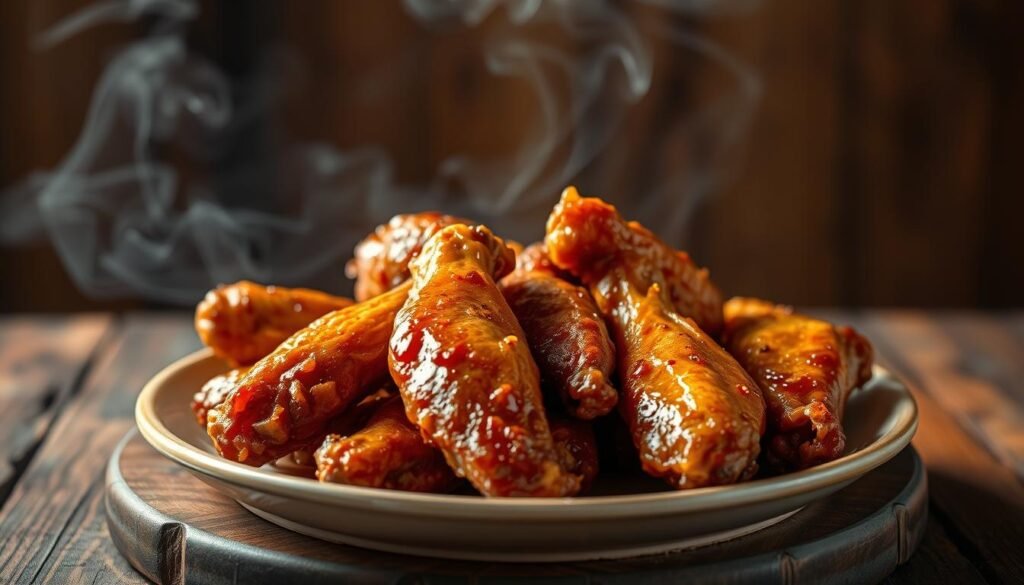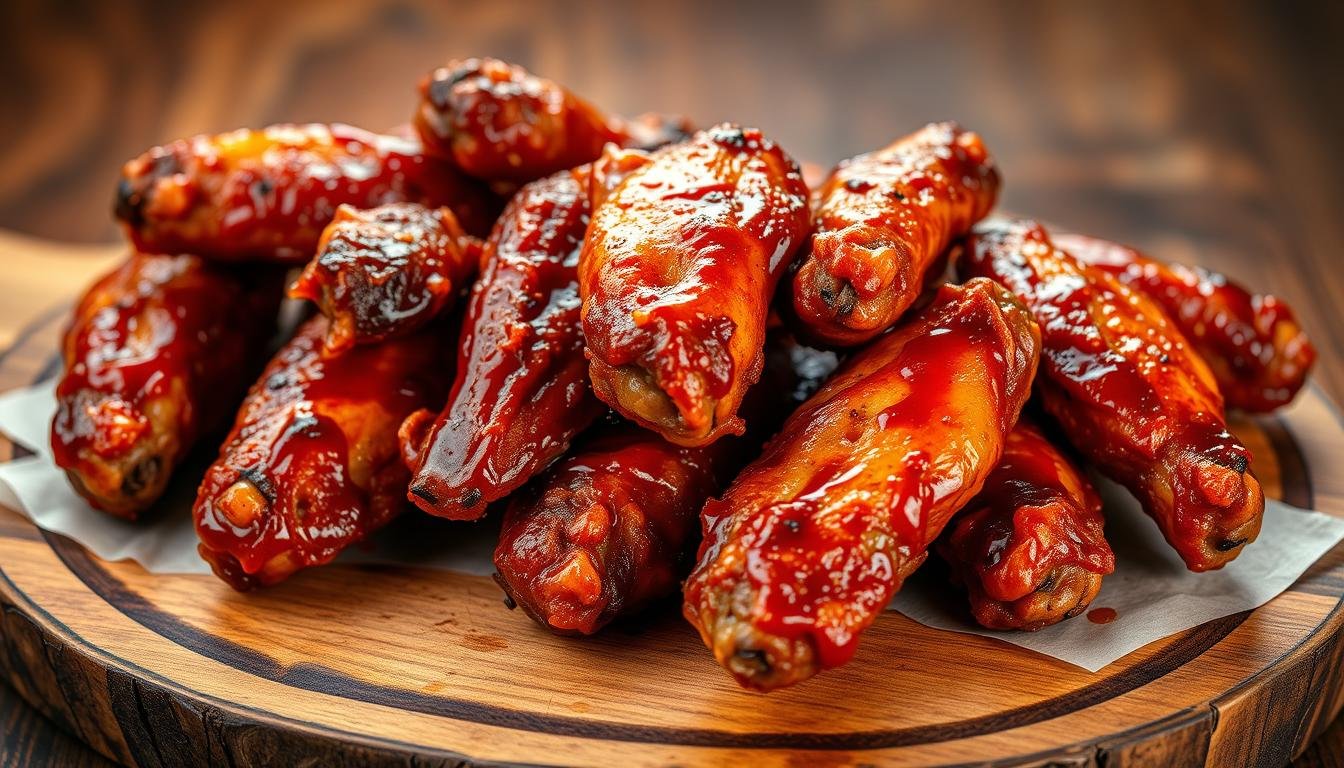What if your favorite game-day snack could fit into a balanced diet? Chicken wings, especially smoked ones, have become a staple in American cuisine. During Super Bowl 2020 alone, fans devoured a staggering 1.4 billion wings. But does this beloved meal align with modern health trends?
Smoked meats offer rich flavor and high protein, but concerns linger about preparation methods. Many wonder if indulging in this comfort food comes with hidden costs. The USDA provides nutritional tools to help make informed choices.
This article explores both sides—weighing protein benefits against potential risks. Whether you follow paleo, keto, or just love good food, understanding the facts empowers better decisions. Let’s dive into what makes this dish so popular and how to enjoy it wisely.
Key Takeaways
- Americans consume billions of chicken wings annually, especially during events like the Super Bowl.
- Smoking adds flavor but may introduce health considerations worth noting.
- Protein content in wings supports muscle health, making them a popular choice.
- Dietary trends like paleo and keto allow for modified versions of traditional recipes.
- USDA tools help track nutritional intake for balanced meal planning.
Introduction: The Popularity and Health Debate Around Smoked Wings
From tailgates to bars, chicken wings dominate American snack culture. Fans devour over 1.33 billion yearly, proving their status as a go-to food for gatherings. Yet, their preparation methods spark heated discussions among nutrition experts.

Smoked meats deliver bold flavors, but concerns arise over potential health trade-offs. The World Health Organization classifies processed meats as Group 1 carcinogens, linking them to increased cancer risks. This adds complexity to an already polarizing topic.
Why the enduring love for wings? Three factors stand out:
- Flavor: Smoking enhances taste with rich, savory notes.
- Social appeal: Shared plates foster connection during events.
- Protein punch: They’re a solid source of muscle-building nutrients.
Brands like Westside Pizza offer oven-roasted versions as a lighter alternative. Whether smoked or baked, moderation and smart pairings can align this favorite with a balanced lifestyle. Next, we’ll break down the nutritional highs and lows.
Nutritional Benefits of Smoked Wings
Beyond their crispy exterior lies a surprising nutritional profile worth exploring. When prepared thoughtfully, this game-day favorite offers more than just bold flavor—it’s a powerhouse of essential fuel for your body.

High Protein and Nutrient Density
Each wing delivers 6.4g of protein, supporting muscle repair and growth. Chicken also packs B-complex vitamins, crucial for energy metabolism. For immunity, zinc and iron content shines—one serving covers 10% of your daily needs.
Fat-soluble vitamins A, D, E, and K are present too. These aid vision, bone health, and antioxidant defense. Pasture-raised options boost benefits further, with 50% more vitamins than conventional wings.
Smart Choices for Balanced Eating
Portion control matters. Six wings fit neatly into a 2,000-calorie diet when paired with veggies. Brands like Westside Pizza set examples by publishing detailed nutritional charts, helping you track intake.
Opt for pasture-raised when possible. Studies show they contain 3x more omega-3s and 21% less saturated fat. This makes them a smarter pick for heart health without sacrificing taste.
Potential Health Risks of Smoked Wings
While the rich taste of smoked wings is undeniable, their preparation methods raise important health questions. High-temperature cooking creates compounds that may affect long-term well-being. Moderation and awareness can help you enjoy them wisely.

Carcinogens in Smoked Meats (PAHs and HCAs)
Smoking meat produces polycyclic aromatic hydrocarbons (PAHs) and heterocyclic amines (HCAs). These form when fat drips onto heat sources, creating smoke that clings to food. The National Cancer Institute warns they may damage DNA, increasing cancer risk.
Compared to grilling or baking, smoking generates higher PAH levels. The Cleveland Clinic advises avoiding charred or burnt ends to reduce intake. Even smoked cheese rinds contain these compounds.
Heart Health and Processed Meat Concerns
Frequent consumption of processed meats like smoked wings may strain heart health. High sodium in rubs and sauces can elevate blood pressure. The Mediterranean Diet suggests limiting red meat to once weekly.
Studies link smoked products to higher stroke and diabetes risks. Opting for lean cuts and homemade seasonings helps mitigate these effects.
Portion Control and Frequency
Balance is key. The American Cancer Society recommends enjoying smoked meats rarely. Stick to 6 wings per meal max, paired with fiber-rich sides like veggies.
Baking or air-frying offers healthier alternatives without sacrificing crunch. Reserve smoked versions for occasional treats to minimize health risks.
How to Make Smoked Wings Healthier
Enjoying flavorful food while keeping nutrition in check is easier than you think. Simple swaps and smart techniques can transform this classic dish into a better-for-you option. Let’s explore practical ways to reduce risks without losing taste.

Lean Cuts and Better Cooking Techniques
Start with skinless cuts to slash calories by 30%. Hardwoods like hickory or applewood create cleaner smoke than softwoods. For oven-baked crispiness, try 400°F for 30 minutes, then finish at 180°F.
Air fryers work wonders too—390°F for 22 minutes delivers golden perfection. These methods cut harmful compounds while keeping texture intact. Westside Pizza’s gluten-free options prove alternatives can satisfy diverse diets.
DIY Rubs and Sauces
Skip store-bought mixes loaded with sodium. Whip up your own blend using:
- Turmeric (anti-inflammatory benefits)
- Garlic powder (heart-healthy properties)
- Smoked paprika (rich flavor without additives)
For sauces, try this keto-friendly buffalo version with just five ingredients. Their honey habanero dry rub offers a lower-sodium way to spice things up.
Smart Side Pairings
Balance your plate with fiber-rich companions. Roasted Brussels sprouts add crunch, while jicama slaw brings refreshing contrast. A simple salad with blue cheese dressing completes the meal nutritiously.
Portion care matters—stick to six pieces per serving. This way, you savor the experience without overdoing it. Temperature control and quality ingredients make all the difference.
Conclusion: Are Smoked Wings a Healthy Choice?
Balancing flavor and nutrition doesn’t mean giving up your favorite snacks. The answer depends on sourcing, cooking methods, and portion size. Pasture-raised options offer more omega-3s and fewer additives, while oven-baking reduces harmful compounds.
Think of smoked chicken wings as an occasional treat. Pair them with veggie sides to align with a Mediterranean diet. For health-conscious choices, focus on lean cuts and homemade rubs.
Each wing packs lean protein and essential vitamins, making them a smart pick in moderation. Use USDA tools to tailor meals to your lifestyle. Enjoy the crunch—just keep it balanced.




